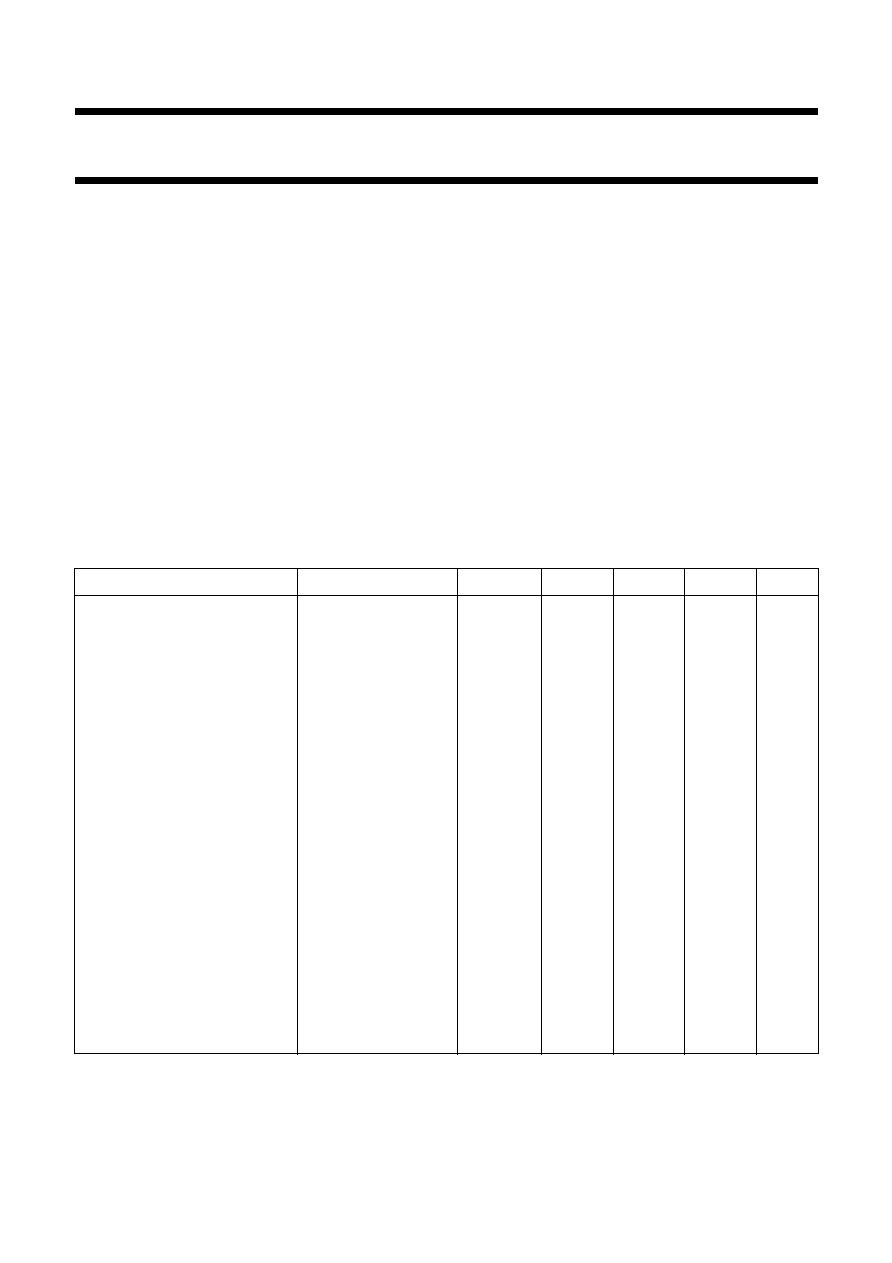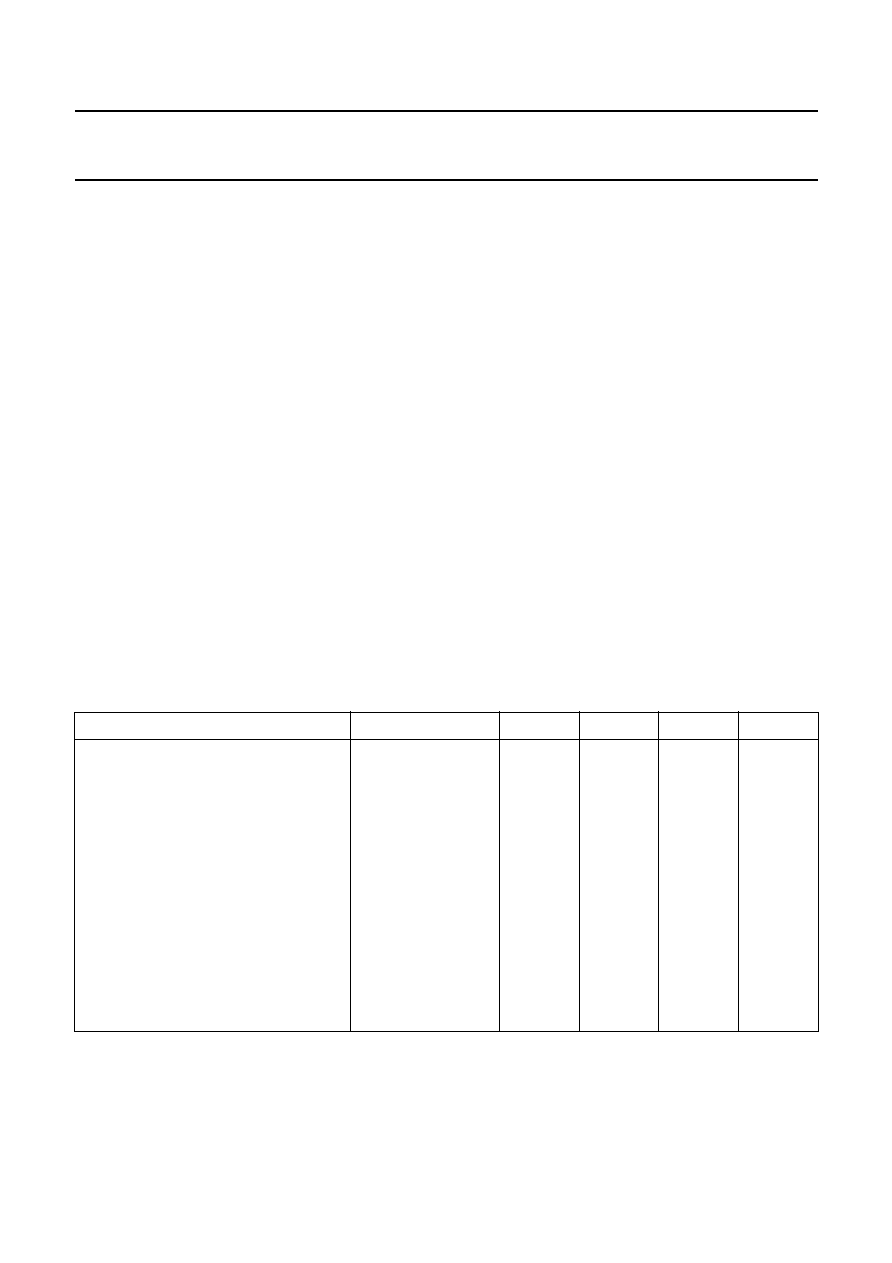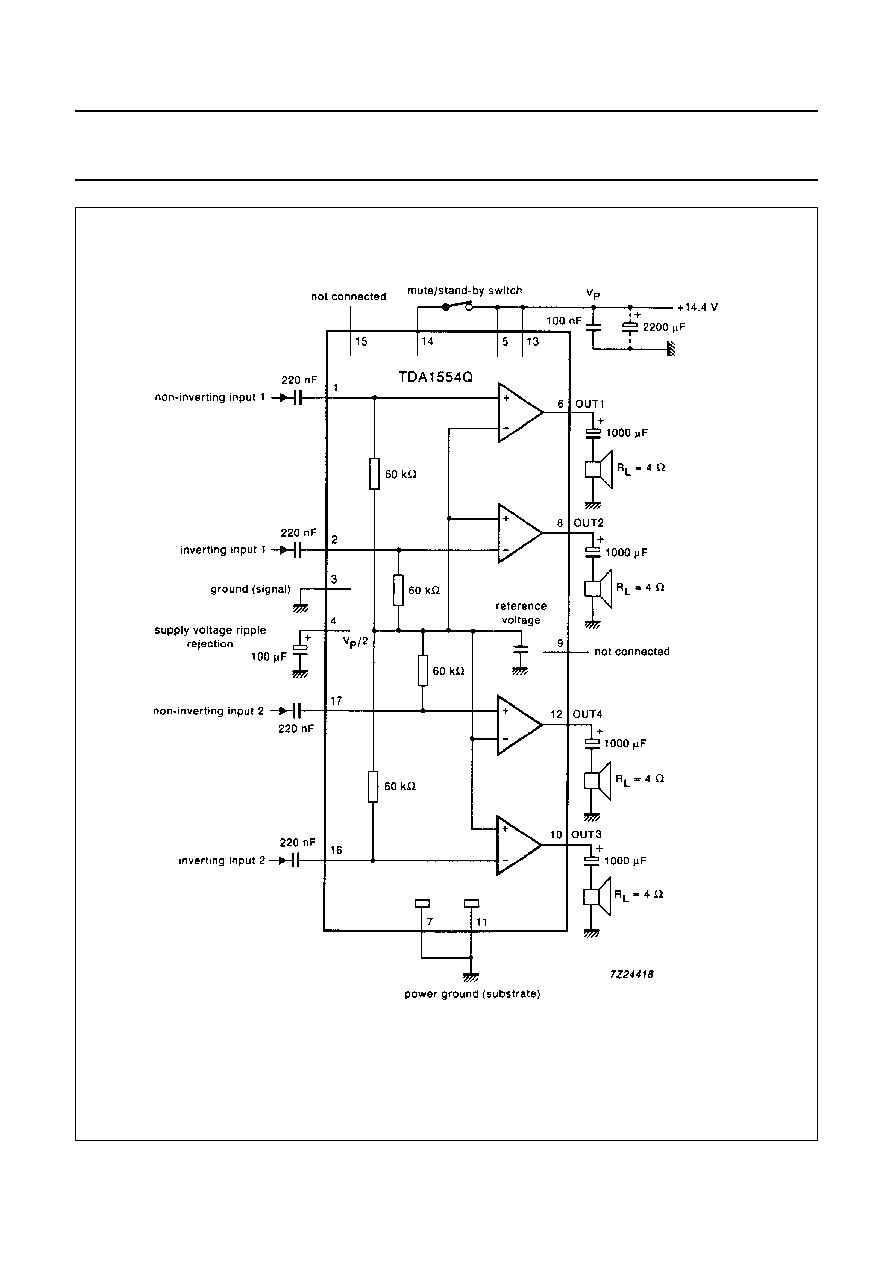 | –≠–ª–µ–∫—Ç—Ä–æ–Ω–Ω—ã–π –∫–æ–º–ø–æ–Ω–µ–Ω—Ç: TDA1554 | –°–∫–∞—á–∞—Ç—å:  PDF PDF  ZIP ZIP |

DATA SHEET
Product specification
File under Integrated Circuits, IC01
May 1992
INTEGRATED CIRCUITS
TDA1554Q
4 x 11 W single-ended or 2 x 22 W
power amplifier

May 1992
2
Philips Semiconductors
Product specification
4 x 11 W single-ended or 2 x 22 W power
amplifier
TDA1554Q
GENERAL DESCRIPTION
The TDA1554Q is an integrated class-B output amplifier in a 17-lead single-in-line (SIL) plastic power package.
The circuit contains 4 x 11 W single-ended or 2 x 22 W bridge amplifiers. The device is primarily developed for car radio
applications.
Features
∑
Requires very few external components
∑
Flexibility in use
-
Quad single-ended or stereo BTL
∑
High output power
∑
Low offset voltage at outputs (important for BTL)
∑
Fixed gain
∑
Good ripple rejection
∑
Mute/stand-by switch
∑
Load dump protection
∑
AC and DC short-circuit-safe to ground and V
P
∑
Thermally protected
∑
Reverse polarity safe
∑
Capability to handle high energy on outputs (V
P
= 0 V)
∑
Protected against electrostatic discharge
∑
No switch-on/switch-off plop
∑
Low thermal resistance
∑
Identical inputs (inverting and non-inverting)
∑
Flexible leads.
QUICK REFERENCE DATA
PACKAGE OUTLINE
17-lead SIL-bent-to-DIL; plastic power (SOT243R); SOT243-1; 1996 July 23.
PARAMETER
CONDITIONS
SYMBOL
MIN.
TYP.
MAX.
UNIT
Supply voltage range
operating
V
P
6.0
14.4
18.0
V
Repetitive peak output current
I
ORM
-
-
4
A
Total quiescent current
I
tot
-
80
160
mA
Stand-by current
I
sb
-
0.1
100
µ
A
Stereo BTL application
Output power
R
L
= 4
; THD = 10%
P
o
20
22
-
W
Supply voltage ripple rejection
RR
48
-
-
dB
Noise output voltage
(RMS value)
R
S
= 0
V
no(rms)
-
70
-
µ
V
Input impedance
|Z
I
|
25
30
38
k
DC output offset voltage
|
V
o
|
-
-
100
mV
Quad single-ended application
Output power
THD = 10%
R
L
= 4
P
o
-
6
-
W
R
L
= 2
P
o
-
11
-
W
Supply voltage ripple rejection
RR
48
-
-
dB
Noise output voltage
(RMS value)
R
S
= 0
V
no(rms)
-
50
-
µ
V
Input impedance
|Z
I
|
50
60
75
k

May 1992
3
Philips Semiconductors
Product specification
4 x 11 W single-ended or 2 x 22 W power
amplifier
TDA1554Q
Fig.1 Block diagram.

May 1992
4
Philips Semiconductors
Product specification
4 x 11 W single-ended or 2 x 22 W power
amplifier
TDA1554Q
PINNING
FUNCTIONAL DESCRIPTION
The TDA1554Q contains four identical amplifiers with differential input stages (two inverting and two non-inverting) and
can be used for single-ended or bridge applications. The gain of each amplifier is fixed at 20 dB (26 dB in BTL). A special
feature of this device is:
Mute/stand-by switch
∑
low stand-by current (< 100
µ
A)
∑
low mute/stand-by switching current (low cost supply switch)
∑
mute facility
RATINGS
Limiting values in accordance with the Absolute Maximum System (IEC 134)
1
NINV1
non-inverting input 1
9
n.c.
not connected
2
INV1
inverting input 1
10
OUT3
output 3
3
GND
ground (signal)
11
GND2
power ground 2 (substrate)
4
RR
supply voltage ripple rejection
12
OUT4
output 4
5
V
P1
positive supply voltage 1
13
V
P2
positive supply voltage 2
6
OUT1
output 1
14
M/SS
mute/stand-by switch
7
GND1
power ground 1 (substrate)
15
n.c.
not connected
8
OUT2
output 2
16
INV2
inverting input 2
17
NINV2
non-inverting input 2
PARAMETER
CONDITIONS
SYMBOL
MIN.
MAX.
UNIT
Supply voltage
operating
V
P
-
18
V
non-operating
V
P
-
30
V
load dump protected
during 50 ms;
t
r
2.5 ms
V
P
-
45
V
Non-repetitive peak output current
I
OSM
-
6
A
Repetitive peak output current
I
ORM
-
4
A
Storage temperature range
T
stg
-
55
+
150
∞
C
Junction temperature
T
j
-
150
∞
C
AC and DC short-circuit-safe voltage
V
PSC
-
18
V
Energy handling capability at outputs
V
P
= 0 V
-
200
mJ
Reverse polarity
V
PR
-
6
V
Total power dissipation
see Fig.2
P
tot
-
60
W

May 1992
5
Philips Semiconductors
Product specification
4 x 11 W single-ended or 2 x 22 W power
amplifier
TDA1554Q
Fig.2 Power derating curve.
DC CHARACTERISTICS
V
P
= 14.4 V; T
amb
= 25
∞
C; measurements taken using Fig.4; unless otherwise specified
PARAMETER
CONDITIONS
SYMBOL
MIN.
TYP.
MAX.
UNIT
Supply
Supply voltage range
note 1
V
P
6.0
14.4
18.0
V
Total quiescent current
I
tot
-
80
160
mA
DC output voltage
note 2
V
O
-
6.9
-
V
DC output offset voltage
|
V
O
|
-
-
100
mV
Mute/stand-by switch
Switch-on voltage level
V
ON
8.5
-
-
V
Mute condition
V
mute
3.3
-
6.4
V
Output signal in mute
V
I
= 1 V (max);
position
f = 1 kHz
V
O
-
-
2
mV
DC output offset voltage
(between pins 6 to 8 and 10 to 12)
|
V
O
|
-
-
100
mV
Stand-by condition
V
sb
0
-
2
V
DC current in
stand-by condition
I
sb
-
-
100
µ
A
Switch-on current
I
sw
-
12
40
µ
A

May 1992
6
Philips Semiconductors
Product specification
4 x 11 W single-ended or 2 x 22 W power
amplifier
TDA1554Q
AC CHARACTERISTICS
V
P
= 14.4 V; R
L
= 4
; f = 1 kHz; T
amb
= 25
∞
C; measurements taken using Fig.3 for stereo BTL application and Fig.4 for
quad single-ended application unless otherwise specified
PARAMETER
CONDITIONS
SYMBOL
MIN.
TYP.
MAX.
UNIT
Stereo BTL application
Output power
THD = 0.5%
P
o
15
17
-
W
THD = 10%
P
o
20
22
-
W
Output power at V
P
= 13.2 V
THD = 0.5%
P
o
-
12
-
W
THD = 10%
P
o
-
17
-
W
Total harmonic distortion
P
o
= 1 W
THD
-
0.1
-
%
Power bandwidth
THD = 0.5%
P
o
=
-
1 dB
w.r.t. 15 W
B
w
-
20 to
-
Hz
15 000
Low frequency roll-off
note 3
-
1 dB
f
L
-
45
-
Hz
High frequency roll-off
-
1 dB
f
H
20
-
-
kHz
Closed loop voltage gain
G
v
25
26
27
dB
Supply voltage ripple rejection
note 4
ON
RR
48
-
-
dB
mute
RR
48
-
-
dB
stand-by
RR
80
-
-
dB
Input impedance
|Z
i
|
25
30
38
k
Noise output voltage
(RMS value)
ON
R
S
= 0
; note 5
V
no(rms)
-
70
-
µ
V
ON
R
S
= 10 k
;
note 5
V
no(rms)
-
100
200
µ
V
mute
notes 5 and 6
V
no(rms)
-
60
-
µ
V
Channel separation
R
S
= 10 k
40
-
-
dB
Channel unbalance
|
G
v
|
-
-
1
dB

May 1992
7
Philips Semiconductors
Product specification
4 x 11 W single-ended or 2 x 22 W power
amplifier
TDA1554Q
Notes to the characteristics
1. The circuit is DC adjusted at V
P
= 6 V to 18 V and AC operating at V
P
= 8.5 V to 18 V.
2. At 18 V < V
P
< 30 V the DC output voltage
V
P
/2.
3. Frequency response externally fixed.
4. Ripple rejection measured at the output with a source impedance of 0
(maximum ripple amplitude of 2 V) and a
frequency between 100 Hz and 10 kHz.
5. Noise voltage measured in a bandwidth of 20 Hz to 20 kHz.
6. Noise output voltage independent of R
S
(V
I
= 0 V).
7. Output power is measured directly at the output pins of the IC.
Quad single-ended application
Output power
note 7
THD = 0.5%
P
o
4
5
-
W
THD = 10%
P
o
5.5
6
-
W
Output power at R
L
= 2 W
note 7
THD = 0.5%
P
o
7.5
8.5
-
W
THD = 10%
P
o
10
11
-
W
Total harmonic distortion
P
o
= 1 W
THD
-
0.1
-
%
Low frequency roll-off
note 3
-
3 dB
f
L
-
45
-
Hz
High frequency roll-off
-
1 dB
f
H
20
-
-
kHz
Closed loop voltage gain
G
v
19
20
21
dB
Supply voltage ripple rejection
note 4
ON
RR
48
-
-
dB
mute
RR
48
-
-
dB
stand-by
RR
80
-
-
dB
Input impedance
|Z
i
|
50
60
75
k
Noise output voltage
(RMS value)
ON
R
S
= 0
; note 5
V
no(rms)
-
50
-
µ
V
ON
R
S
= 10 k
;
note 5
V
no(rms)
-
70
100
µ
V
mute
notes 5 and 6
V
no(rms)
-
50
-
µ
V
Channel separation
R
S
= 10 k
40
-
-
dB
Channel unbalance
|
G
v
|
-
-
1
dB
PARAMETER
CONDITIONS
SYMBOL
MIN.
TYP.
MAX.
UNIT

May 1992
8
Philips Semiconductors
Product specification
4 x 11 W single-ended or 2 x 22 W power
amplifier
TDA1554Q
APPLICATION INFORMATION
Fig.3 Stereo BTL application circuit diagram.

May 1992
9
Philips Semiconductors
Product specification
4 x 11 W single-ended or 2 x 22 W power
amplifier
TDA1554Q
Fig.4 Quad single-ended application circuit diagram.

May 1992
10
Philips Semiconductors
Product specification
4 x 11 W single-ended or 2 x 22 W power
amplifier
TDA1554Q
PACKAGE OUTLINE
REFERENCES
OUTLINE
VERSION
EUROPEAN
PROJECTION
ISSUE DATE
IEC
JEDEC
EIAJ
DIMENSIONS (mm are the original dimensions)
Note
1. Plastic or metal protrusions of 0.25 mm maximum per side are not included.
SOT243-1
0
5
10 mm
scale
D
L
E
A
c
A
2
L
3
Q
w
M
b
p
1
d
D
Z
e
e
x
h
1
17
j
Eh
non-concave
95-03-11
97-12-16
DBS17P: plastic DIL-bent-SIL power package; 17 leads (lead length 12 mm)
SOT243-1
view B: mounting base side
m
2
e
v
M
B
UNIT
A
e
1
A
2
b
p
c
D
(1)
E
(1)
Z
(1)
d
e
D
h
L
L
3
m
mm
17.0
15.5
4.6
4.2
0.75
0.60
0.48
0.38
24.0
23.6
20.0
19.6
10
2.54
v
0.8
12.2
11.8
1.27
e
2
5.08
2.4
1.6
E
h
6
2.00
1.45
2.1
1.8
3.4
3.1
4.3
12.4
11.0
Q
j
0.4
w
0.03
x

May 1992
11
Philips Semiconductors
Product specification
4 x 11 W single-ended or 2 x 22 W power
amplifier
TDA1554Q
SOLDERING
Introduction
There is no soldering method that is ideal for all IC
packages. Wave soldering is often preferred when
through-hole and surface mounted components are mixed
on one printed-circuit board. However, wave soldering is
not always suitable for surface mounted ICs, or for
printed-circuits with high population densities. In these
situations reflow soldering is often used.
This text gives a very brief insight to a complex technology.
A more in-depth account of soldering ICs can be found in
our
"IC Package Databook" (order code 9398 652 90011).
Soldering by dipping or by wave
The maximum permissible temperature of the solder is
260
∞
C; solder at this temperature must not be in contact
with the joint for more than 5 seconds. The total contact
time of successive solder waves must not exceed
5 seconds.
The device may be mounted up to the seating plane, but
the temperature of the plastic body must not exceed the
specified maximum storage temperature (T
stg max
). If the
printed-circuit board has been pre-heated, forced cooling
may be necessary immediately after soldering to keep the
temperature within the permissible limit.
Repairing soldered joints
Apply a low voltage soldering iron (less than 24 V) to the
lead(s) of the package, below the seating plane or not
more than 2 mm above it. If the temperature of the
soldering iron bit is less than 300
∞
C it may remain in
contact for up to 10 seconds. If the bit temperature is
between 300 and 400
∞
C, contact may be up to 5 seconds.
DEFINITIONS
LIFE SUPPORT APPLICATIONS
These products are not designed for use in life support appliances, devices, or systems where malfunction of these
products can reasonably be expected to result in personal injury. Philips customers using or selling these products for
use in such applications do so at their own risk and agree to fully indemnify Philips for any damages resulting from such
improper use or sale.
Data sheet status
Objective specification
This data sheet contains target or goal specifications for product development.
Preliminary specification
This data sheet contains preliminary data; supplementary data may be published later.
Product specification
This data sheet contains final product specifications.
Limiting values
Limiting values given are in accordance with the Absolute Maximum Rating System (IEC 134). Stress above one or
more of the limiting values may cause permanent damage to the device. These are stress ratings only and operation
of the device at these or at any other conditions above those given in the Characteristics sections of the specification
is not implied. Exposure to limiting values for extended periods may affect device reliability.
Application information
Where application information is given, it is advisory and does not form part of the specification.










